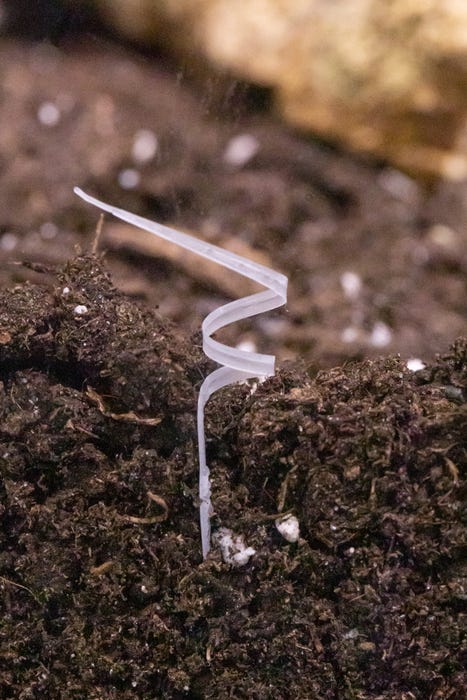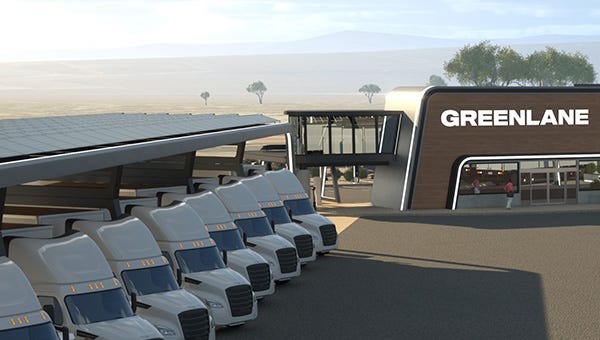The Weekly Anthropocene, May 3 2023
Ancient logjams in the Mackenzie River Delta, a network of electric truck stops, robots for environmental science, bowhead whales in the Chukchi Sea, and more!
Northwest Territories, Canada
A new study in Geophysical Research Letters has made the first full scientific description of a highly understudied carbon sink: vast, ancient logjams in Northern Canada’s Arctic river deltas. (Fallen timber in other river deltas tends to decompose, but it’s preserved in the far north). The researchers found over 400,000 individual wood deposits in the Northwest Territories’ Mackenzie River delta, and used high-resolution satellite imagery to estimate that at least 3.1 × 1012 grams of carbon (3.1 million metric tonnes) are stored in all this wood1. There could be up to twice carbon as much if there’s more timber that’s been buried by sediments or overgrown by vegetation.
Carbon dating revealed that about 40% of the trees in the logjam are from 1955 or later, but that some had been there much longer, stretching back to 700 CE! Furthermore, there are a dozen other Arctic river deltas of comparable size that probably have unmapped wood deposits (e.g. Siberia’s great Lena River) so northern river delta logjams could be a considerable unknown factor in the global carbon cycle. Climate change will likely alter these “Arctic wood pump” systems, though there’s no clear evidence how. A really interesting piece of research!
Climate Action in America
Truck company Daimler, renewables company NextEra Energy, and financial titan BlackRock have announced a new $650 million partnership, Greenlane, to build out a network of electric truck stops across America. The first Greenlane truck step is set to be built in Southern California, with networks planned along routes on the East and West Coasts and in Texas. Most existing EV chargers aren’t designated to accommodate large trucks, so this is a key step in fully electrifying American transportation! Great news.
The Biden Administration is strongly expected to be on the point of releasing unprecedently ambitious new EPA limits on greenhouse gas emissions from fossil fuel power plants. Notably, these regulations are rumored to rely on the Inflation Reduction Act’s tax credits for carbon capture (adding tech to smokestacks to capture carbon dioxide emissions), in a fascinating reversal of carbon capture’s usual role as an “excuse” for fossil fuel giants to slow decarbonization. The IRA financially supporting carbon capture makes it possible to legally argue that massive emissions cuts are now technologically feasible for fossil fuel plants to achieve and yet continue operating. However, carbon capture technology has a long history of being highly expensive and then not working, so in practice most energy providers will likely choose to just speed up their switch to tried-and-true renewable energy. (And if someone manages to get carbon capture working well after all, that’ll reduce emissions as well). Even if the new rules don’t survive a Republican Supreme Court (very possible), their mere existence and the possibility of future Democratic presidencies reinstituting them will likely incentivize utilities to switch to renewables much faster. This is a highly innovative policy that could greatly accelerate US decarbonization!
The American EV & battery industry continues to grow rapidly!
General Motors announced plans for its fourth EV battery factory in the US, a $3 billion partnership with Samsung with an as-yet-unrevealed location. GM already has three EV battery factories operating or in the works in Ohio, Tennessee, and Michigan.
Hyundai finalized plans with battery manufacturer SK On to build a $5 billion EV battery factory in Bartow County, Georgia. This will help supply Hyundai’s electric vehicle factory in Savannah, Georgia, which started construction in October 2021.
In an unexpected major victory for climate jurisprudence, the U.S. Supreme Court declined to hear an appeal from the fossil fuel industry that sought to move an array of climate lawsuits to federal courts. This means that a range of climate lawsuits will now be heard in state courts, where US states, cities, and counties (including Rhode Island, Baltimore, Honolulu, and more) are suing fossil fuel companies for damages from climate disasters they’ve experienced. Veteran climate activist Bill McKibben calls this a “seismic win,” arguing that state courts may well end up forcing fossil fuel companies to make painful monetary settlements similar to those paid by tobacco companies to 46 states in 1998.
Robots for Environmental Science



Several recently invented “soft robots” could herald a new class of flexible, unobtrusive environmental science tools, with potential wide applicability around the world.
Scientists at the Italian Institute of Technology in Genoa have created a soft, seed-like robot that can wriggle into soil to collect data on pollutants, carbon, temperature, and humidity.
Researchers at the Max Planck Institute for Intelligent Systems in Stuttgart are working on a jellyfish-like swimming soft robot capable of collecting and retrieving trash, or fragile biological samples like fish eggs.
And an MIT lab in 2018 deployed a “soft robotic fish” capable of being remote-controlled by divers and unobtrusively following and taking video of real fish without disturbing them. A Ph.D candidate at the Worcester Polytechnic Institute is also developing a robotic fish focused on collecting temperature data to gain a high-resolution understanding of the oceans’ changing microclimates.
Chukchi Sea

Bowhead whales (Balaena mysticetus) from the Bering-Chukchi-Beaufort population2, have an ancient and well-defined migration pattern. They normally spend the winter in the northern Pacific’s Bering Sea, then pass north through the Bering Strait to spend the summer in the Arctic Ocean’s Chukchi and Beaufort seas. Now, a new study in Movement Ecology used 11 years of acoustic monitoring data to find that some bowhead whales are remaining in the Chukchi Sea for the winter instead of heading south. The change is almost certainly due to reduced sea ice cover making the Arctic more accessible year-round; the study also found that the northward spring migration is beginning earlier in years with lower ice area in the Chukchi Sea. This is already affecting the broader ecosystem, as aerial surveys have revealed orcas (another species moving north into the Arctic and staying longer) beginning to prey on bowhead whales there. As the Arctic continues to warm, we’re going to be seeing more and more Atlantic and Pacific marine ecosystems expanding northward.
While little-known to the general public, bowhead whales are truly extraordinary life-forms to be sharing a planet with. Capable of living for 200 years and growing to 62 feet long, they have been recorded singing many different songs (believed to be courtship-related) and rarely repeating themselves. Although the novel ecosystems forming in the changing Arctic remain mysterious, these fascinating creatures are facing the Anthropocene in a good position: commercial whaling reduced their global population to under 3,000 individuals by the early 20th century, but due to a post-whaling rebound there are now more than 25,000 bowhead whales worldwide. Here’s hoping they find a thriving future and krill-rich waters!
In the global scheme of things, 3.1 million metric tonnes is a considerable but not game-changing amount of carbon, about as much as the yearly emissions of 2.5 million old-fashioned gas-powered cars.
One of several bowhead whale populations spread across the northern oceans of Earth.






